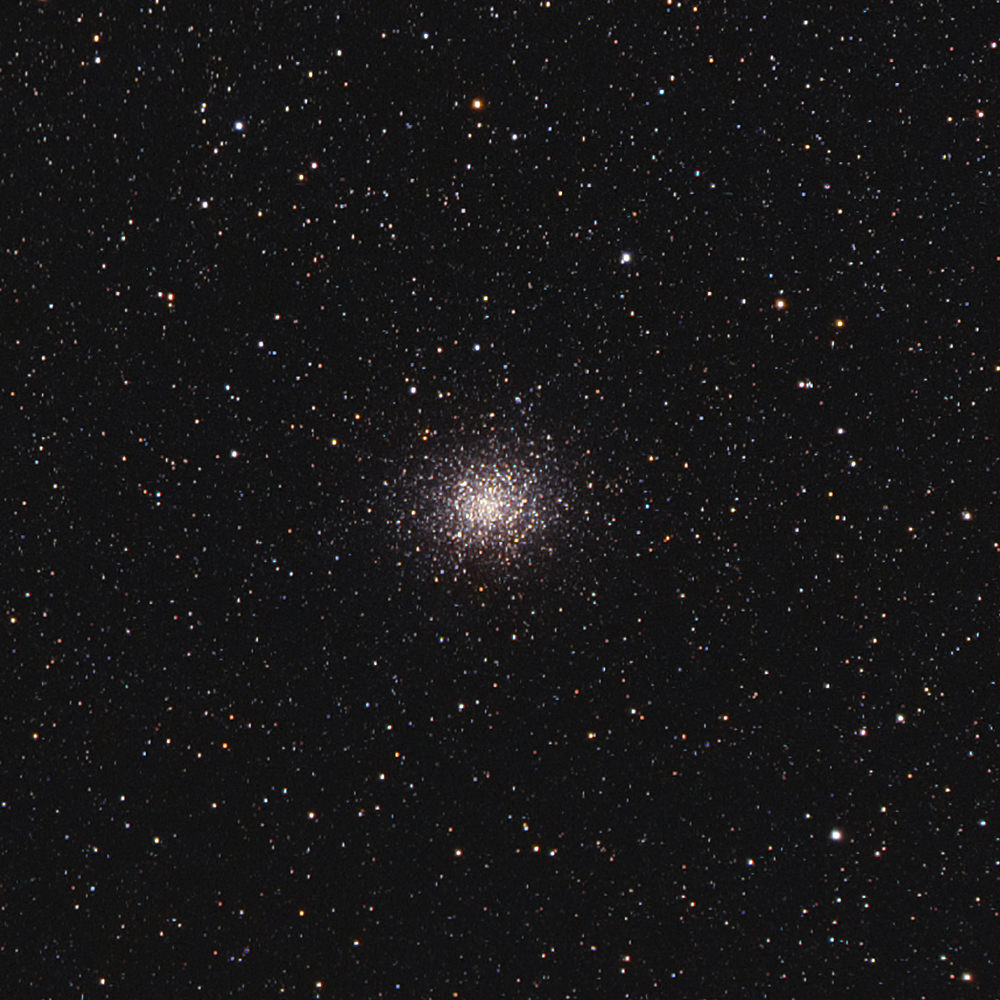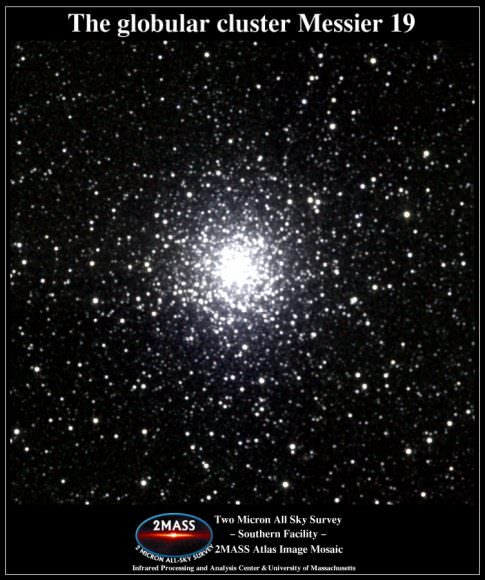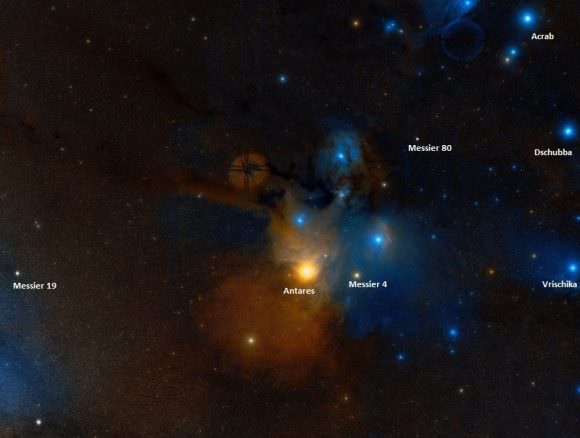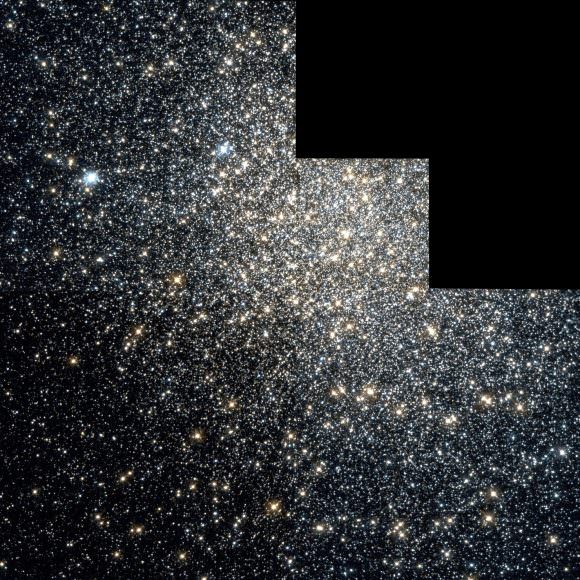Welcome back to Messier Monday! In our ongoing tribute to the great Tammy Plotner, we take a look at the Messier 19 globular star cluster. Enjoy!
In the 18th century, while searching the night sky for comets, French astronomer Charles Messier began noticing a series of "nebulous objects" in the night sky. Hoping to ensure that other astronomers did not make the same mistake, he began compiling a list of these objects,. Known to posterity as the
Messier Catalog
, this list has come to be one of the most important milestones in the research of Deep Sky objects.
One of these objects is Messier 19, a globular star cluster located in the constellation
Ophiuchus
. Of all the known globular clusters, M19 appears to be one of the most oblate (i.e. flattest) in the night sky. Discovered by William Herschel, this cluster is relatively difficult to spot with the naked eye, and appears as a fuzzy point of light with the help of magnification.
Description:
Speeding away from us at a rate of 146 kilometers per second, this gravitationally bound ball of stars measuring 140 light years in diameter, is one of the Messier globular clusters that has the distinction of being closest to the center of the Milky Way. At a little more than 5000 light-years from the intense gravitation of our own galactic core, it has played havoc on M19's round shape.
In essence, Milky Way's gravity has caused M19 to become one of the most oblate of all globular clusters, with twice as many stars along the major axis as along the minor. And, although it is 28,000 light-years from Earth, it's actually on the opposite side of the galactic core. For all of its rich, dense mass, four RR Lyrae variable stars have been found in M19.
[caption id="attachment_128145" align="aligncenter" width="580"]
The constellation Ophiuchis. Credit: iau.org
[/caption]
Is Messier 19 unique? It has some stellar branch properties that are difficult to pinpoint. And even its age (though estimated at around 11.9 billion years old) is indeterminate. Says F. Meissner and A. Weiss in their 2006 study, "
Global fitting of globular cluster age indicators
":
What's occurring is a horizontal branch gap - an not-quite explainable difference in the way the stars inside M19 are aging. However, science is looking for the answer. As G. Busso et al. explained in their 2008 paper titled "
The Peculiar Horizontal Branch Morphology of the Galactic Globular Clusters NGC 6388 and NGC 6441
":
[caption id="attachment_129926" align="aligncenter" width="485"]
The Messier 19 globular cluster, as viewed by the Two Micron All-Sky Survey (2MASS). Credit: 2MASS/ipac.caltech.edu
[/caption]
Is helium the answer? Quite probably so. M. Salaris Astrophysics Research Institute and an international team of researchers explained in their 2004 study "
The initial helium abundance of the Galactic globular cluster system
":
History of Observation:
M19 was one of Charles Messier's original discoveries, which he first observed on June 5th, 1764. In his notes, he wrote:
[caption id="attachment_129927" align="aligncenter" width="580"]
The Messier 19 globular cluster, relative to M4, M80 and Antares. Credit: Wikisky
[/caption]
While Charles didn't resolve it, we must give him due credit for discovery, for its size wouldn't make it a particularly easy object given his optics. Later, in 1784, William Herschel would become the first to open up its true identity:
While you may - or may not - resolve Messier 19's individual stars, even small telescopes can pick up on some of its ellipticity and larger telescopes will make out a definite blue tinge to its coloration. Before you yawn at viewing another globular cluster, remember that you are looking at the other side of our galactic center and think on the words about M19 from Admiral Symth.
"The whole vicinity," he wrote, "afford a grand conception of the grandeur and richness even of the exterior creation; and indicate the beautious gradation and variety of the heaven of heavens. Truly has it been said, "Stars teach us as well as shine." This is near the large opening or hole, about 4deg broad, in the Scorpion's body, which WH [William Herschel] found almost destitute of stars."
[caption id="attachment_129929" align="aligncenter" width="580"]
The Messier 19 globular cluster, as imaged by the Hubble Space Telescope. Credit:NASA/STSc /HST/WikiSky
[/caption]
Locating Messier 19:
Finding M19's location in binoculars is quite easy - it's less than a fistwidth (8 degrees) east of Antares (Alpha Scorpi). However, 'seeing' M19 in binoculars (especially smaller ones) is a little more problematic. The steadier the binoculars are, the better your chances, since it will appear almost stellar at first glance. A good indicator is to have optical double 26 Ophiuchi in the field at the 2:00 position and look for the star that won't quite come to focus in the 8:00 position.
Star 26 also makes for a great finderscope lead when locating M19 in a telescope as well. Even for aperture sizes as small as 114mm, this globular cluster will show quite easily in a telescope and reveal its oblate nature. When aperture size increase to the 8" range, it will begin resolution and as it nears 12" or more, you'll pick up on blue stars.
And for your convenience, here are the quick facts of M19:
- Object Name
-
Messier 19
- Alternative Designations
-
M19, NGC 6273
- Object Type
-
Class VIII Globular Star Cluster
- Constellation
-
Ophiuchus
- Right Ascension
-
17 : 02.6 (h:m)
- Declination
-
-26 : 16 (deg:m)
- Distance
-
28.0 (kly)
- Visual Brightness
-
6.8 (mag)
- Apparent Dimension
-
17.0 (arc min)
We have written many interesting articles about Messier Objects here at Universe Today. Here's Tammy Plotner's
Introduction to the Messier Objects
, ,
M1 – The Crab Nebula
,
M8 – The Lagoon Nebula
, and David Dickison's articles on the
2013
and
2014
Messier Marathons.
Be to sure to check out our complete
Messier Catalog
. And for more information, check out the
SEDS Messier Database
.
 Universe Today
Universe Today




